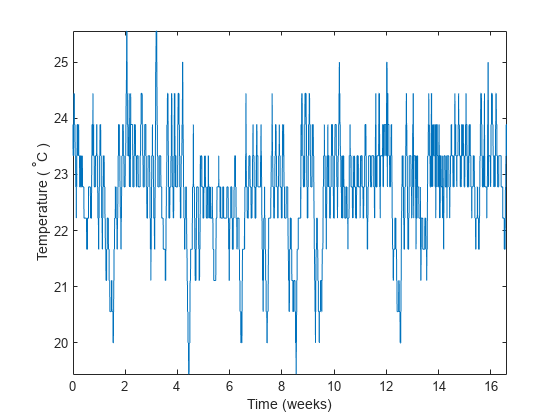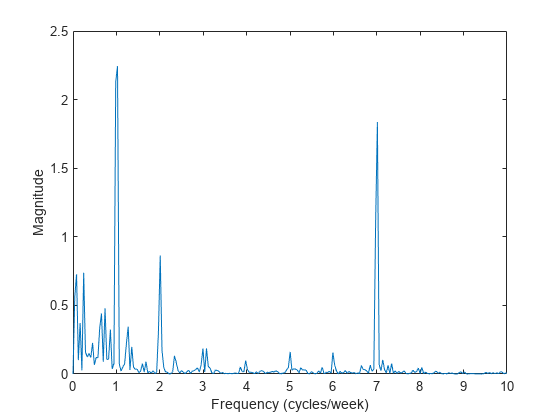使用频率分析求周期性
发布时间:2023年12月31日
????????通常很难通过观察时间测量值来表征数据中的振荡行为。频谱分析有助于确定信号是否为周期性信号并测量不同周期。
????????办公楼内的温度计每半小时测量一次室内温度,持续四个月。加载数据并对其绘图。将温度转换为摄氏度。测量时间以周为单位。因此,采样率为 2 次测量/小时 × 24 小时/天 × 7 天/周 = 336 次测量/周。
load officetemp
tempC = (temp - 32)*5/9;
fs = 2*24*7;
t = (0:length(tempC) - 1)/fs;
plot(t,tempC)
xlabel('Time (weeks)')
ylabel('Temperature ( {}^\circC )')
axis tight如图所示:

????????温度似乎确实有震荡特性,但周期的长度并不容易确定。此时,看看信号的频率成分。
????????减去均值以重点关注温度波动。计算并绘制周期图。
tempnorm = tempC - mean(tempC);
[pxx,f] = periodogram(tempnorm,[],[],fs);
plot(f,pxx)
ax = gca;
ax.XLim = [0 10];
xlabel('Frequency (cycles/week)')
ylabel('Magnitude')如图所示:

????????温度显然有日周期和周周期。结果并不令人惊讶:在人们工作时温度较高,晚上和周末温度较低。
文章来源:https://blog.csdn.net/jk_101/article/details/134421285
本文来自互联网用户投稿,该文观点仅代表作者本人,不代表本站立场。本站仅提供信息存储空间服务,不拥有所有权,不承担相关法律责任。 如若内容造成侵权/违法违规/事实不符,请联系我的编程经验分享网邮箱:chenni525@qq.com进行投诉反馈,一经查实,立即删除!
本文来自互联网用户投稿,该文观点仅代表作者本人,不代表本站立场。本站仅提供信息存储空间服务,不拥有所有权,不承担相关法律责任。 如若内容造成侵权/违法违规/事实不符,请联系我的编程经验分享网邮箱:chenni525@qq.com进行投诉反馈,一经查实,立即删除!
最新文章
- Python教程
- 深入理解 MySQL 中的 HAVING 关键字和聚合函数
- Qt之QChar编码(1)
- MyBatis入门基础篇
- 用Python脚本实现FFmpeg批量转换
- 【python学习】面向对象编程1
- Flask 小程序菜品搜索
- K8S实践:非常实用kubectl的别名工具推荐,助你高效工作
- 003-90-14【SparkSQL&DF&DS】龙井村寸头二大爷家女儿小红用GPT 学习DataFrame 的创建和使用--入门教程
- 5个月市值缩水超百亿,Keep股价九连跌
- C++学习笔记(四十):c++ 预编译头文件
- 乒乓球室计时计费软件,乒乓球馆怎么计时
- 项目经理的“四定、五起、六法”工作法
- 【计组考点】:第二章 数据信息的表示
- 监督学习 - 梯度提升回归(Gradient Boosting Regression)